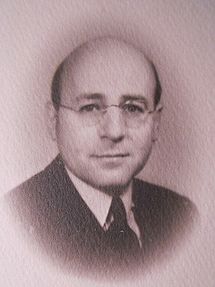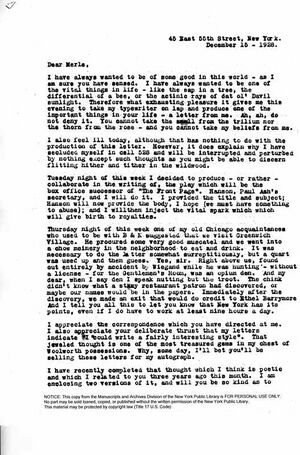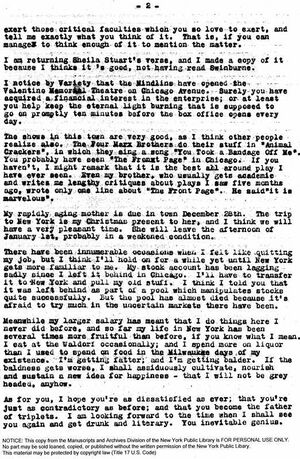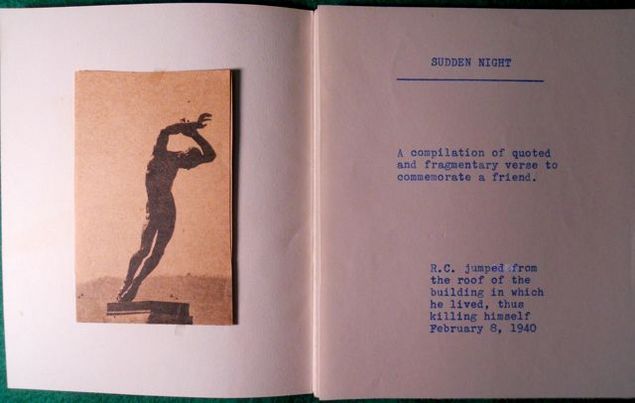Leo Adams: A Gay Life in Letters, 1928–1952
Curated by Michael S. Miller
Leo Adams, Becoming Visible, and the New York Public Library
In 1992 Leo Adams, a retired Macy's management executive, donated his personal papers to the Stonewall History Project, a collaboration of the New York Public Library and several other cultural institutions in New York City organized to commemorate the twenty-fifth anniversary of the Stonewall Riots. The exhibit that grew out of the project, Becoming Visible: The Legacy of Stonewall, ran at the New York Public Library's Gottesman Exhibition Hall from June 18 to September 24, 1994, receiving record crowds and enthusiastic reviews.[1] In a note to exhibit co-curator Fred Wasserman written at the time of his donation Leo Adams offered the following assessment of his collected letters:
Many years ago I started to save carbon copies of letters which I wrote, thinking that eventually when I was old (I am now 89 years of age) I might use them to help compose such a record as you are apparently engaged in doing.
Individuals thought the letters were amusing and informative at the time. They may still have some such value in revealing the activity and interest currently engaging the gay world when it was quite underground.
If you care to get in touch with me I shall be pleased to show you part of the collection of carbons on hand and possibly contribute a bit to your enterprise.
None of us ever thought the entire subject would be as open and widely discussed as it now is, orally and on record. Just as an instance I should like to mention that the overseas edition of the Manchester Guardian recently mentioned the long sexual intimacy between Laurence Olivier and Danny Kaye. That, even to me, was a surprise, although I recall Olivier acting in "The Green Bay Tree" so naturally.
In her preface to the 1998 book based on the exhibit, Becoming Visible: An Illustrated History of Lesbian and Gay Life in Twentieth-Century America, Mimi Bowling, then Curator of Manuscripts at the NYPL, wrote:
- The exhibition…propelled the continuing acquisition of lesbian and gay collections into a whole new dimension as people began to realize that much of the memorabilia in their attics (and closets) was historically important.[3]
And so it was with Leo Adams's letters. Although none of his archive appears to have made it into the exhibit or the subsequent publication (although he is quoted in the book), his papers joined the rapidly expanding LGBT Collections at the NYPL following the exhibit. Adams's papers, comprising nearly 1,000 letters and postcards, a few photos, several poetry manuscripts, and a type-script anthology of poems memorializing the death by suicide of a former lover, might be said to have become part of what Michel Foucault vividly characterized as an "insurrection of subjugated knowledges," which began to infiltrate the shelves of libraries, archives, and special collections in the years following the Stonewall Riots. Foucault described these "subjugated knowledges" as "historical contents that have been buried or masked in functional coherences or formal systematizations."[4] In the years from 1928–1952, the period covered by the Leo Adams Papers, the "gay world" that Adams's letters reveal existed largely under ground––buried in medical, ecclesiastical, and criminal justice discourses, and masked behind doctrines of inversion, perversion and vice.
This exhibit attempts to present a selection of Leo Adams's correspondence in a way that Adams himself might have found both "amusing and informative" had this collaborative, Internet-based platform been as familiar to him as his carbon-copied archive of correspondence. Leo Adams: A Gay Life in Letters treats his papers as contributing to a kind of genealogy of knowledge about the gay past. Foucault defines this genealogy as the "coupling together of scholarly erudition and local memories, which allows us to constitute a historical knowledge of struggles and to make use of that knowledge in contemporary tactics."[5] It is coincidental, but nonetheless symbolically meaningful, therefore, that this archive entered the historical record in conjunction with Becoming Visible––a commemoration of the Stonewall Riots––the most visible act of resistance in modern lesbian and gay history.
In 1952 Leo Adams suddenly stopped archiving his correspondence, even though he would live another 43 active and engaged years in his bachelor apartment on East 42nd Street. A few years earlier he had written to his friends Dorothy and Nick Kiley:
Leo Adams could not, perhaps, have foreseen the coming revolution and the role his personal archive would play in the queer insurrection upon the public record. He was, however, nonetheless prescient in preserving his papers for future generations––sometimes uncannily so. In the second folder of box 2 of the Leo Adams Papers is a typescript anthology of poems––fragments of melancholy verse assembled to commemorate the death by suicide of a former lover. Adams distributed a very limited edition of this chapbook to his coterie of readers, including the artist Wesley Lea, to whom he wrote on the subject:
Adams got it pretty close: Becoming Visible, the exhibit that brought his papers, including his memorial to "R.C.," into the New York Public Library, opened on June 18, 1994––almost fifty years to the day since he wrote that letter, and a little more than a year before his death at age 92. His New York Times obituary states that Leo Adams "was honored by a request from The New York Pubic Library for copies of his correspondence covering many, many years which are now available to scholars via the Library's 'new state-of-the-art storing facility, cataloged on the globally available research libraries information network'." [6] If this exhibit aspires to anything, it is to honor Leo Adams' wish that there be "prominent speculation" about the contents of his archive (if not in the magazines and newspapers, then here in this twenty-first century medium), and to contribute to making not only the library's catalog entry, but much of the relevant content of his letters available not only to researchers, but also to LGBTQ laypersons around the globe with an interest in our cultural heritage.
Exhibit Pages
Reading Material
Nightlife and Entertainment
Cruising for Sex
Language and Self-Representation
Wilde, Whitman, and the Gay Literary Style
Timeline
- 1903 - Leo Adams is born on July 9 in Menominee, Michigan.
- 1925 - Moves to Chicago and works as Assistant Manager for the 4,000 seat Chicago Theater.
- 1928 - Moves from Chicago, IL in late summer to a bachelor apartment at the Allerton House at 45 East 55th Street in New York City. Works as Maintenance Supervisor for Fox Theaters during their transition from silent to sound production.
- 1930 - Moves from the Allerton House men's residence to another bachelor apartment at 136 West 55th Street.
- 1930 - Loses position with Fox Theaters.
- 1931 - Begins employment with R. H. Macy & Co. department store. Moves into the Shelton Hotel apartments at 50 East 66th Street.
- 1947 - Makes his final move to a bachelor apartment at Woodstock Towers on East 42nd Street in Tudor City.
- 1952 - Stops archiving his correspondence.
- 1965 - Retires from Macy's.
- 1992 - Offers to contribute his correspondence to the Stonewall History Project.
- 1994 - The exhibit Becoming Visible: The Legacy of Stonewall opens at the New York Public Library on June 18.
- 1995 - Leo Adams dies on July 18 at the age of 92, leaving no immediately family, but a circle of friends spanning several generations.
Curator
Michael S. Miller is a Ph.D. student in English at the Graduate Center of the City University of New York and a Graduate Teaching Fellow at Queens College, CUNY. His primary research interest is the development of a gay male literary culture in the U.S. and the development gay literature in the 1920s and 1930s. In addition to popular literature of the period, he has recently begun to explore lesbian and gay archives and personal papers for documentation of reading habits and the sharing of information among gay men about gay literature. In his previous career, Michael worked in HIV/AIDS and LGBTQ youth services, with management positions at AIDS Action Committee of Massachusetts, The Massachusetts Governor's Commission on Gay and Lesbian Youth, and the Harvard AIDS Institute. He can be contacted via email at mmiller3@gc.cuny.edu
Notes
- ↑ The New York Times reported that, on the Saturday before the Stonewall 25 march down Fifth Avenue, the exhibit received over 5,000 visitors, exceeding the record set the previous year by the library's Dead Sea Scrolls exhibit. David W. Dunlap, "Library's Gay Show Is an Eye-Opener, Even for Its Subjects," New York Times, September 6, 1994.
- ↑ Leo Adams to Fred Wasserman, Sept 8, 1992. Leo Adams Papers, New York Public Library (hereafter cited by name and date only).
- ↑ Molly McGarry and Fred Wasserman, Becoming Visible: An Illustrated History of Lesbian and Gay Life in Twentieth-Century America (New York: Penguin Studio, 1998), x.
- ↑ Michel Foucault, Society Must Be Defended: Lectures at the Collège de France (New York: Picador, 2003), 7.
- ↑ Ibid., 8.
- ↑ New York Times, July 23, 1995.
<comments />




